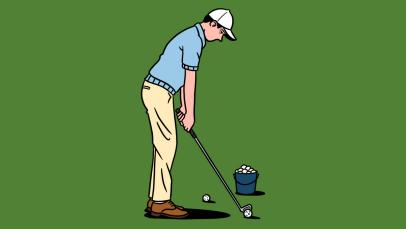This article first appeared in Low Net, a Golf Digest+ exclusive newsletter written for the average golfer, by an average golfer. Have a topic you want me to explore? Send me an email at Samuel.Weinman@wbd.com.
Golfers tend to resent opponents who don’t give short putts, but I’ve determined there’s someone way worse. It’s the golfer not given a short putt who goes on to miss the short putt, and then complains about not being given the short putt in the first place.
I figure if a putt’s long enough for me to miss it—basically anything not already in the hole—then I can’t begrudge anyone forcing me to make it. There are even occasions when I scoop up a conceded putt that I am struck by a small case of impostor syndrome walking to the next tee. He thought that putt wasn’t a problem for me? What an idiot!
On the long list of weird golf dynamics, one of the weirdest is when a ball settles three feet from the hole and everyone stands around looking at each other as if the world hangs in the balance. The data shows we’re far too charitable, something Golf Digest’s Drew Powell wrote about last year. Before you determine your “circle of friendship,” consider the average 80s shooter only makes 64 percent of three-footers and 57 percent of four-footers, according to Arccos stat guru Lou Stagner. Perhaps most sobering: A player who shoots in the 90s is more likely to miss a four-footer than to make it.
I have golf friends who fall on both sides of the gimme divide. Some liberally rake putts, while my normal group is so stringent about holing everything, the groups behind waiting in the fairway usually start hating us by the time we walk off the second green.

Who is right? This is where it gets complicated. If the object of the game is to get the ball in the hole, the last part seems kind of important. One of my favorite mini-dramas last summer was when I hosted a round for our Golf Digest Match Play and the end hinged on two short putts—one conceded, one not. It proved to be such a compelling case study, we even brought in Ryder Cup hero Paul Azinger for analysis (Paul’s take: you gotta make ‘em when they count)
But in certain match-play situations, especially factoring in pace of play, the calculus gets fuzzier. In a four-ball setting, it’s reasonable to want to see players putt out anything that matters and have everyone scoop up the rest. Same goes for a singles match where the hole has been decided before you have even putted. For handicapping purposes, the USGA says those players are supposed to enter their “most likely score” based on their position. But even their guidelines are subject to interpretation. Here's their chart:

Never mind that I’ve already established I’m perfectly capable of missing a three-foot putt. Whenever you factor in subjective phrases like “depending on the position of the ball … and the ability of the player,” you’re bound to get wildly divergent answers. Frankly, it might be the biggest fault line in the vanity handicapper/sandbagger divide, separating the players who always give themselves certain putts and those who make sure they never do.
Whenever I’ve raised this dilemma with my golf group, they’ll respond that’s why we should putt everything, an honorable solution that also risks keeping everyone at the course past sunset. More honorable is to just be brutally honest with what you would and wouldn’t make. At one point or another, golf arrives at the truth regardless.





